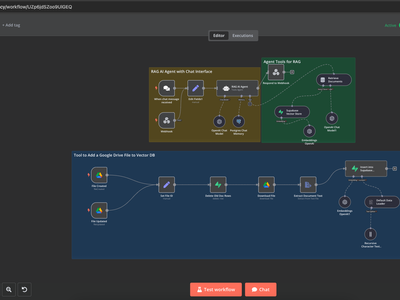Step 1: Installing Docker
Update the package index:
Install Docker:
Start Docker:
Enable Docker to start at boot:
Step 2: Starting n8n in Docker
Run the following command to start n8n in Docker. Replace your-domain.com with your actual domain name:
If you are using a subdomain, it should look like this:
Explanation of the command:
- Downloads and runs the n8n Docker image.
- Exposes n8n on port 5678.
- Sets environment variables for the n8n host and webhook tunnel URL.
- Mounts the n8n data directory for persistent storage.
After executing the command, n8n will be accessible at your-domain.com:5678.
Step 3: Installing Nginx
Nginx is a reverse proxy that forwards requests to n8n and handles SSL termination.
Install Nginx:
Step 4: Configuring Nginx
Configure Nginx to reverse proxy the n8n web interface.
Create a new Nginx configuration file:
sudo nano /etc/nginx/sites-available/n8n.conf
Paste the following configuration:
Replace your-domain.com with your actual domain name.
Enable the configuration:
sudo ln -s /etc/nginx/sites-available/n8n.conf /etc/nginx/sites-enabled/n8n.conf
Test the Nginx configuration and restart the service:
Step 5: Setting up SSL with Certbot
Certbot will obtain and install an SSL certificate from Let's Encrypt.
Install Certbot and the Nginx plugin:
Obtain an SSL certificate:
Follow the on-screen instructions to complete the SSL setup. Once completed, n8n will be securely accessible over HTTPS at your-domain.com.

Important Notes
- Ensure your domain's DNS A record points to your server's IP address.
- Allow ports 80 (HTTP), 443 (HTTPS), and 5678 (n8n) in your server's firewall.
- Nginx handles SSL termination, so it internally forwards requests to the n8n instance over HTTP.
Why Nginx and Certbot?
- Nginx: Acts as a reverse proxy, forwarding client requests to n8n running on Docker. This setup enhances security, load balancing, and scalability.
- Certbot: A tool from the Electronic Frontier Foundation (EFF) that automates obtaining and renewing SSL certificates from Let's Encrypt, a free and open Certificate Authority.
By using Nginx and Certbot, you ensure that your n8n instance is securely accessible over the internet with HTTPS.
Troubleshooting
- If you encounter issues with Nginx, check the logs located at /var/log/nginx/error.log for more details.
- For Docker-related issues, ensure the Docker service is running:
